#A-GAS Electronic Materials
Explore tagged Tumblr posts
Text
Advanced Equipment for High-Quality Services at A-Gas Electronic Materials
Explore the wide range of advanced equipment at A-Gas Electronic Materials, ensuring top-notch services for our customers. Our state-of-the-art tools include CVS analysis, Yamoto wafer plating, rectifiers, and more. Trust us for precision and reliability in all your industrial needs.
#advanced equipment#CVS analysis#Yamoto wafer plating#rectifiers#insoluble anodes#inorganic analysis#heaters#filter media#pumps and filters#anodes#Electrum precious metal recovery#Titraline inorganic titration#A-Gas Electronic Materials
2 notes
·
View notes
Text
MIT chemists synthesize plant-derived molecules that hold potential as pharmaceuticals
New Post has been published on https://thedigitalinsider.com/mit-chemists-synthesize-plant-derived-molecules-that-hold-potential-as-pharmaceuticals/
MIT chemists synthesize plant-derived molecules that hold potential as pharmaceuticals


MIT chemists have developed a new way to synthesize complex molecules that were originally isolated from plants and could hold potential as antibiotics, analgesics, or cancer drugs.
These compounds, known as oligocyclotryptamines, consist of multiple tricyclic substructures called cyclotryptamine, fused together by carbon–carbon bonds. Only small quantities of these compounds are naturally available, and synthesizing them in the lab has proven difficult. The MIT team came up with a way to add tryptamine-derived components to a molecule one at a time, in a way that allows the researchers to precisely assemble the rings and control the 3D orientation of each component as well as the final product.
“For many of these compounds, there hasn’t been enough material to do a thorough review of their potential. I’m hopeful that having access to these compounds in a reliable way will enable us to do further studies,” says Mohammad Movassaghi, an MIT professor of chemistry and the senior author of the new study.
In addition to allowing scientists to synthesize oligocyclotryptamines found in plants, this approach could also be used to generate new variants that may have even better medicinal properties, or molecular probes that can help to reveal their mechanism of action.
Tony Scott PhD ’23 is the lead author of the paper, which appears today in the Journal of the American Chemical Society.
Fusing rings
Oligocyclotryptamines belong to a class of molecules called alkaloids — nitrogen-containing organic compounds produced mainly by plants. At least eight different oligocyclotryptamines have been isolated from a genus of flowering plants known as Psychotria, most of which are found in tropical forests.
Since the 1950s, scientists have studied the structure and synthesis of dimeric cyclotryptamines, which have two cyclotryptamine subunits. Over the past 20 years, significant progress has been made characterizing and synthesizing dimers and other smaller members of the family. However, no one has been able to synthesize the largest oligocyclotryptamines, which have six or seven rings fused together.
One of the hurdles in synthesizing these molecules is a step that requires formation of a bond between a carbon atom of one tryptamine-derived subunit to a carbon atom of the next subunit. The oligocyclotryptamines have two types of these linkages, both containing at least one carbon atom that has bonds with four other carbons. That extra bulk makes those carbon atoms less accessible to undergo reactions, and controlling the stereochemistry — the orientation of the atoms around the carbon — at all these junctures poses a significant challenge.
For many years, Movassaghi’s lab has been developing ways to form carbon-carbon bonds between carbon atoms that are already crowded with other atoms. In 2011, they devised a method that involves transforming the two carbon atoms into carbon radicals (carbon atoms with one unpaired electron) and directing their union. To create these radicals, and guide the paired union to be completely selective, the researchers first attach each of the targeted carbon atoms to a nitrogen atom; these two nitrogen atoms bind to each other.
When the researchers shine certain wavelengths of light on the substrate containing the two fragments linked via the two nitrogen atoms, it causes the two atoms of nitrogen to break away as nitrogen gas, leaving behind two very reactive carbon radicals in close proximity that join together almost immediately. This type of bond formation has also allowed the researchers to control the molecules’ stereochemistry.
Movassaghi demonstrated this approach, which he calls diazene-directed assembly, by synthesizing other types of alkaloids, including the communesins. These compounds are found in fungi and consist of two ring-containing molecules, or monomers, joined together. Later, Movassaghi began using this approach to fuse larger numbers of monomers, and he and Scott eventually turned their attention to the largest oligocyclotryptamine alkaloids.
The synthesis that they developed begins with one molecule of cyclotryptamine derivative, to which additional cyclotryptamine fragments with correct relative stereochemistry and position selectivity are added, one at a time. Each of these additions is made possible by the diazene-directed process that Movassaghi’s lab previously developed.
“The reason why we’re excited about this is that this single solution allowed us to go after multiple targets,” Movassaghi says. “That same route provides us a solution to multiple members of the natural product family because by extending the iteration one more cycle, your solution is now applied to a new natural product.”
“A tour de force”
Using this approach, the researchers were able to create molecules with six or seven cyclotryptamine rings, which has never been done before.
“Researchers worldwide have been trying to find a way to make these molecules, and Movassaghi and Scott are the first to pull it off,” says Seth Herzon, a professor of chemistry at Yale University, who was not involved in the research. Herzon described the work as “a tour de force in organic synthesis.”
Now that the researchers have synthesized these naturally occurring oligocyclotryptamines, they should be able to generate enough of the compounds that their potential therapeutic activity can be more thoroughly investigated.
They should also be able to create novel compounds by switching in slightly different cyclotryptamine subunits, Movassaghi says.
“We will continue to use this very precise way of adding these cyclotryptamine units to assemble them together into complex systems that have not been addressed yet, including derivatives that could potentially have improved properties,” he says.
The research was funded by the U.S. National Institute of General Medical Sciences.
#3d#ADD#Antibiotics#approach#atom#atoms#attention#author#Cancer#cancer drugs#carbon#carbon atoms#challenge#chemical#chemistry#directing#drug development#drug discovery#drugs#electron#form#fungi#gas#it#LESS#Light#material#medical#members#Method
0 notes
Text
A Tour of Cosmic Temperatures
We often think of space as “cold,” but its temperature can vary enormously depending on where you visit. If the difference between summer and winter on Earth feels extreme, imagine the range of temperatures between the coldest and hottest places in the universe — it’s trillions of degrees! So let’s take a tour of cosmic temperatures … from the coldest spots to the hottest temperatures yet achieved.
First, a little vocabulary: Astronomers use the Kelvin temperature scale, which is represented by the symbol K. Going up by 1 K is the same as going up 1°C, but the scale begins at 0 K, or -273°C, which is also called absolute zero. This is the temperature where the atoms in stuff stop moving. We’ll measure our temperatures in this tour in kelvins, but also convert them to make them more familiar!
We’ll start on the chilly end of the scale with our CAL (Cold Atom Lab) on the International Space Station, which can chill atoms to within one ten billionth of a degree above 0 K, just a fraction above absolute zero.

Credit: NASA's Goddard Space Flight Center/Scott Wiessinger
Just slightly warmer is the Resolve sensor inside XRISM, pronounced “crism,” short for the X-ray Imaging and Spectroscopy Mission. This is an international collaboration led by JAXA (Japan Aerospace Exploration Agency) with NASA and ESA (European Space Agency). Resolve operates at one twentieth of a degree above 0 K. Why? To measure the heat from individual X-rays striking its 36 pixels!

Credit: NASA's Goddard Space Flight Center/Scott Wiessinger
Resolve and CAL are both colder than the Boomerang Nebula, the coldest known region in the cosmos at just 1 K! This cloud of dust and gas left over from a Sun-like star is about 5,000 light-years from Earth. Scientists are studying why it’s colder than the natural background temperature of deep space.

Credit: NASA's Goddard Space Flight Center/Scott Wiessinger
Let’s talk about some temperatures closer to home. Icy gas giant Neptune is the coldest major planet. It has an average temperature of 72 K at the height in its atmosphere where the pressure is equivalent to sea level on Earth. Explore how that compares to other objects in our solar system!

Credit: NASA's Goddard Space Flight Center/Scott Wiessinger
How about Earth? According to NOAA, Death Valley set the world’s surface air temperature record on July 10, 1913. This record of 330 K has yet to be broken — but recent heat waves have come close. (If you’re curious about the coldest temperature measured on Earth, that’d be 183.95 K (-128.6°F or -89.2°C) at Vostok Station, Antarctica, on July 21, 1983.)
We monitor Earth's global average temperature to understand how our planet is changing due to human activities. Last year, 2023, was the warmest year on our record, which stretches back to 1880.

Credit: NASA's Goddard Space Flight Center/Scott Wiessinger
The inside of our planet is even hotter. Earth’s inner core is a solid sphere made of iron and nickel that’s about 759 miles (1,221 kilometers) in radius. It reaches temperatures up to 5,600 K.

Credit: NASA's Goddard Space Flight Center/Scott Wiessinger
We might assume stars would be much hotter than our planet, but the surface of Rigel is only about twice the temperature of Earth’s core at 11,000 K. Rigel is a young, blue star in the constellation Orion, and one of the brightest stars in our night sky.
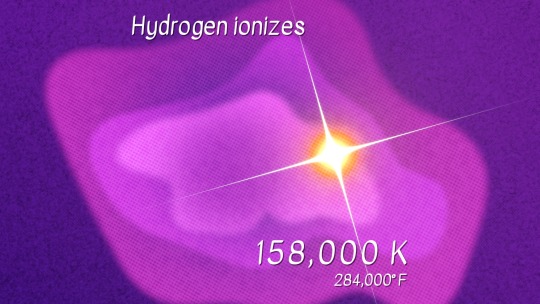
Credit: NASA's Goddard Space Flight Center/Scott Wiessinger
We study temperatures on large and small scales. The electrons in hydrogen, the most abundant element in the universe, can be stripped away from their atoms in a process called ionization at a temperature around 158,000 K. When these electrons join back up with ionized atoms, light is produced. Ionization is what makes some clouds of gas and dust, like the Orion Nebula, glow.

Credit: NASA's Goddard Space Flight Center/Scott Wiessinger
We already talked about the temperature on a star’s surface, but the material surrounding a star gets much, much hotter! Our Sun’s surface is about 5,800 K (10,000°F or 5,500°C), but the outermost layer of the solar atmosphere, called the corona, can reach millions of kelvins.
Our Parker Solar Probe became the first spacecraft to fly through the corona in 2021, helping us answer questions like why it is so much hotter than the Sun's surface. This is one of the mysteries of the Sun that solar scientists have been trying to figure out for years.
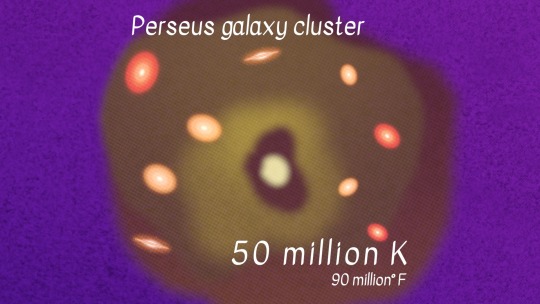
Credit: NASA's Goddard Space Flight Center/Scott Wiessinger
Looking for a hotter spot? Located about 240 million light-years away, the Perseus galaxy cluster contains thousands of galaxies. It’s surrounded by a vast cloud of gas heated up to tens of millions of kelvins that glows in X-ray light. Our telescopes found a giant wave rolling through this cluster’s hot gas, likely due to a smaller cluster grazing it billions of years ago.

Credit: NASA's Goddard Space Flight Center/Scott Wiessinger
Now things are really starting to heat up! When massive stars — ones with eight times the mass of our Sun or more — run out of fuel, they put on a show. On their way to becoming black holes or neutron stars, these stars will shed their outer layers in a supernova explosion. These layers can reach temperatures of 300 million K!

Credit: NASA's Goddard Space Flight Center/Jeremy Schnittman
We couldn’t explore cosmic temperatures without talking about black holes. When stuff gets too close to a black hole, it can become part of a hot, orbiting debris disk with a conical corona swirling above it. As the material churns, it heats up and emits light, making it glow. This hot environment, which can reach temperatures of a billion kelvins, helps us find and study black holes even though they don’t emit light themselves.
JAXA’s XRISM telescope, which we mentioned at the start of our tour, uses its supercool Resolve detector to explore the scorching conditions around these intriguing, extreme objects.

Credit: NASA's Goddard Space Flight Center/CI Lab
Our universe’s origins are even hotter. Just one second after the big bang, our tiny, baby universe consisted of an extremely hot — around 10 billion K — “soup” of light and particles. It had to cool for a few minutes before the first elements could form. The oldest light we can see, the cosmic microwave background, is from about 380,000 years after the big bang, and shows us the heat left over from these earlier moments.

Credit: NASA's Goddard Space Flight Center/Scott Wiessinger
We’ve ventured far in distance and time … but the final spot on our temperature adventure is back on Earth! Scientists use the Large Hadron Collider at CERN to smash teensy particles together at superspeeds to simulate the conditions of the early universe. In 2012, they generated a plasma that was over 5 trillion K, setting a world record for the highest human-made temperature.
Want this tour as a poster? You can download it here in a vertical or horizontal version!
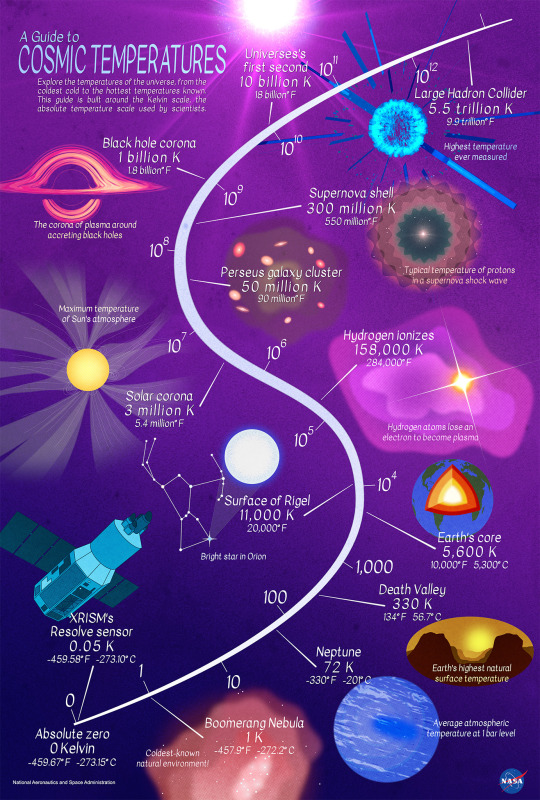
Credit: NASA's Goddard Space Flight Center/Scott Wiessinger
Explore the wonderful and weird cosmos with NASA Universe on X, Facebook, and Instagram. And make sure to follow us on Tumblr for your regular dose of space!
2K notes
·
View notes
Text
Good News - July 22-28
Like these weekly compilations? Tip me at $kaybarr1735 or check out my new(ly repurposed) Patreon!
1. Four new cheetah cubs born in Saudi Arabia after 40 years of extinction

“[T]he discovery of mummified cheetahs in caves […] which ranged in age from 4,000 to as recent as 120 years, proved that the animals […] once called [Saudi Arabia] home. The realisation kick-started the country’s Cheetah Conservation Program to bring back the cats to their historic Arabian range. […] Dr Mohammed Qurban, CEO of the NCW, said: […] “This motivates us to continue our efforts to restore and reintroduce cheetahs, guided by an integrated strategy designed in accordance with best international practices.””
2. In sub-Saharan Africa, ‘forgotten’ foods could boost climate resilience, nutrition

“[A study published in PNAS] examined “forgotten” crops that may help make sub-Saharan food systems more resilient, and more nutritious, as climate change makes it harder to grow [current staple crops.] [… The study identified 138 indigenous] food crops that were “relatively underresearched, underutilized, or underpromoted in an African context,” but which have the nutrient content and growing stability to support healthy diets and local economies in the region. […] In Eswatini, van Zonneveld and the World Vegetable Center are working with schools to introduce hardy, underutilized vegetables to their gardens, which have typically only grown beans and maize.”
3. Here's how $4 billion in government money is being spent to reduce climate pollution

“[New Orleans was awarded] nearly $50 million to help pay for installing solar on low to middle income homes [… and] plans to green up underserved areas with trees and build out its lackluster bike lane system to provide an alternative to cars. […] In Utah, $75 million will fund several measures from expanding electric vehicles to reducing methane emissions from oil and gas production. [… A] coalition of states led by North Carolina will look to store carbon in lands used for agriculture as well as natural places like wetlands, with more than $400 million. [… This funding is] “providing investments in communities, new jobs, cost savings for everyday Americans, improved air quality, … better health outcomes.””
4. From doom scrolling to hope scrolling: this week’s big Democratic vibe shift

“[Democrats] have been on an emotional rollercoaster for the past few weeks: from grim determination as Biden fought to hang on to his push for a second term, to outright exuberance after he stepped aside and Harris launched her campaign. […] In less than a week, the Harris campaign raised record-breaking sums and signed up more than 100,000 new volunteers[….] This honeymoon phase will end, said Democratic strategist Guy Cecil, warning the election will be a close race, despite this newfound exuberance in his party. [… But v]oters are saying they are excited to vote for Harris and not just against Trump. That’s new.”
5. Biodegradable luminescent polymers show promise for reducing electronic waste

“[A team of scientists discovered that a certain] chemical enables the recycling of [luminescent polymers] while maintaining high light-emitting functions. […] At the end of life, this new polymer can be degraded under either mild acidic conditions (near the pH of stomach acid) or relatively low heat treatment (> 410 F). The resulting materials can be isolated and remade into new materials for future applications. […] The researchers predict this new polymer can be applied to existing technologies, such as displays and medical imaging, and enable new applications […] such as cell phones and computer screens with continued testing.”
6. World’s Biggest Dam Removal Project to Open 420 Miles of Salmon Habitat this Fall

“Reconnecting the river will help salmon and steelhead populations survive a warming climate and [natural disasters….] In the long term, dam removal will significantly improve water quality in the Klamath. “Algae problems in the reservoirs behind the dams were so bad that the water was dangerous for contact […] and not drinkable,” says Fluvial Geomorphologist Brian Cluer. [… The project] will begin to reverse decades of habitat degradation, allow threatened salmon species to be resilient in the face of climate change, and restore tribal connections to their traditional food source.”
7. Biden-Harris Administration Awards $45.1 Million to Expand Mental Health and Substance Use Services Across the Lifespan
““Be it fostering wellness in young people, caring for the unhoused, facilitating treatment and more, this funding directly supports the needs of our neighbors,” said HHS Secretary Xavier Becerra. [The funding also supports] recovery and reentry services to adults in the criminal justice system who have a substance use disorder[… and clinics which] serve anyone who asks for help for mental health or substance use, regardless of their ability to pay.”
8. The World’s Rarest Crow Will Soon Fly Free on Maui

“[… In] the latest attempt to establish a wild crow population, biologists will investigate if this species can thrive on Maui, an island where it may have never lived before. Translocations outside of a species’ known historical range are rare in conservation work, but for a bird on the brink of extinction, it’s a necessary experiment: Scientists believe the crows will be safer from predators in a new locale—a main reason that past reintroduction attempts failed. […] As the release date approaches, the crows have already undergone extensive preparation for life in the wild. […] “We try to give them the respect that you would give if you were caring for someone’s elder.””
9. An optimist’s guide to the EV battery mining challenge
““Battery minerals have a tremendous benefit over oil, and that’s that you can reuse them.” [… T]he report’s authors found there’s evidence to suggest that [improvements in technology] and recycling have already helped limit demand for battery minerals in spite of this rapid growth — and that further improvements can reduce it even more. [… They] envision a scenario in which new mining for battery materials can basically stop by 2050, as battery recycling meets demand. In this fully realized circular battery economy, the world must extract a total of 125 million tons of battery minerals — a sum that, while hefty, is actually 17 times smaller than the oil currently harvested every year to fuel road transport.”
10. Peekaboo! A baby tree kangaroo debuts at the Bronx Zoo

“The tiny Matschie’s tree kangaroo […] was the third of its kind born at the Bronx Zoo since 2008. [… A] Bronx Zoo spokesperson said that the kangaroo's birth was significant for the network of zoos that aims to preserve genetic diversity among endangered animals. "It's a small population and because of that births are not very common," said Jessica Moody, curator of primates and small mammals at the Bronx Zoo[, …] adding that baby tree kangaroos are “possibly one of the cutest animals to have ever lived. They look like stuffed animals, it's amazing.””
July 15-21 news here | (all credit for images and written material can be found at the source linked; I don’t claim credit for anything but curating.)
#hopepunk#good news#cheetah#extinct species#africa#nutrition#food#farming#gardening#pollution#climate#climate change#climate crisis#democrats#us politics#us elections#kamala harris#voting#recycling#biodegradable#technology#salmon#habitat#fish#mental illness#mental health#substance abuse#hawaii#electric vehicles#zoo
851 notes
·
View notes
Text
MCSR As Chemical Compounds
idk either man. expect very little actual explanation and a lot of chemical yapping from a very big nerd
Silverr as Silver Nitrate:
AgNO3
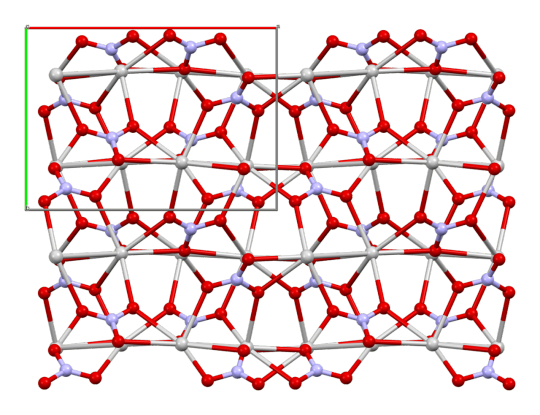
the above is the crystal structure
appearance is just a white crystal kinda like sugar
it took everything in me to not just make silverr plain Ag
silver nitrate is the most common precursor for all other important silver salts
also an extremely important compound in the development of photography! (and iirc silverr is a film major)
Feinberg as Ozone:
O3

produced during lightning strikes
pale blue at high ppm
only leaves gas state at cryogenic temperatures
naturally occurring in the stratosphere and absorbs UV rays from the sun
Fruit as Nickel(II) Chloride Hexahydrate:
NiCl2•6H2O


green
the non-hydrate form is a sort of olive-y yellow color
used to absorb ammonia in gas masks
Raddles as Potassium Permanganate:
KMnO4
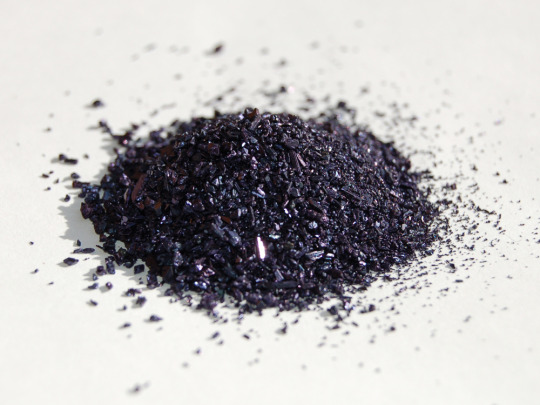

Sometimes referred to as Purple Potion Powder
goes CRAZY purple when dissolved and is lowkey my favorite chemical
very strong oxidizing agent
one time i stained my hand purple through my glove with this shit idk how it happened
if made in specific solvents can look extremely similar to dragon's breath in minecraft imo
K4 as Octathio[8]circulene:
C16S8
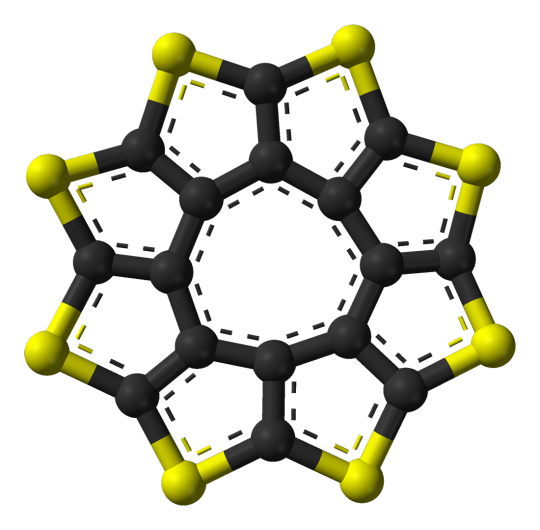
also referred to as Sulflower (like sulfur and sunflower haha get it)
planar which is fairly uncommon for molecules of this size
can be stacked together to make sheets of sulflowers
Cube as Cubane:
C8H8
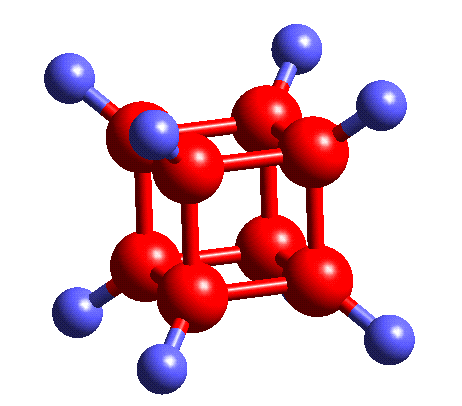
yeah this is self-explanatory
what is interesting though is that ring strain in 4 membered rings/squares is really high, so cubane existing is a bit of a chemical anomaly
i havent read into it enough to know for sure but i suspect that ring strain is why cubane is a precursor to a HELLA STRONG explosive compound
Reignex as PPTA:
Poly-p-paraphenylene terephthalamide
[-CO-C6H4-CO-NH-C6H4-NH-]n

the name is complicated as shit but this is just kevlar!
aka bulletproof vest material
looks fluffy when not woven completely together
aligning of polymer chains w hydrogen bonds creates EXTREMELY high tensile strength
Mime as Phenylmagnesium Bromide:
C6H5MgBr

a common grignard reagent aka a compound that can be used in a grignard reaction, an extremely important reaction in organic synthesis as it creates new C-C bonds
another fun fact about grignard reagents is that if water is added to them- or even if they're handled in particularly moist air- they fucking explode
extremely strong nucleophile and base
Poundcake as Xenon Hexafluoride:
XeF6

Noble gases don't react unless you REALLY make them
so a compound containing xenon is really interesting
colorless as a solid but sublimes (aka skips straight from solid to gas) into a bright yellow gas
fun fact a lot of instances where typical chemistry rules are broken (noble gases not reacting, octet rule in general, etc) involve fluorine to the point ive heard it referred to as a "batshit electron thief"
Fulham as Iron Hexacyanidoferrate:
C18Fe7N18
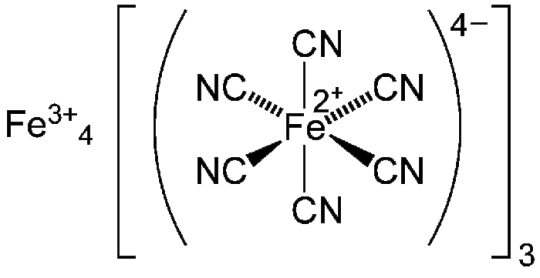

also known as prussian blue
extremely common pigment in paints and the first modern synthetic pigment
used extensively in The Great Wave
another one of my favorite molecules bc im biased and like inorganic chem aka things that contain metals
used as an antidote for heavy metal poisoning which is interesting bc it contains cyanide ligands!
Couriway as Bullvalene:
C10H10
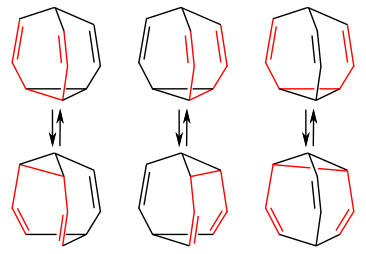
in a state of constant resonance
aka the double bonds are CONSTANTLY shifting and reforming bullvalene into... itself but moved around a little
the bonds fluctuate so rapidly that in nmr analysis each carbon and hydrogen in the entire molecule is read as equivalent (for my non-chem people that's very uncommon and very cool)
formed through photolysis (aka using light/photons to fuel a reaction)
#i made this for me and only me#chemistry is a disease and i will not be getting better anytime soon#90% of these picks are straight soul reads im gonna be so fr#mcsr#hbg#fruitberries#feinberg#couriway#fulham#president poundcake#raddles#silverrruns#reignex#talkingmime#cube1337x#k4yfour
86 notes
·
View notes
Text

Finished the rogue clone au designs :]
Some Au ramblings below the readmore
Gabriel confronts Dmitri about his medical records instead of keeping his discovery secret. Dmitri detains Gabriel and keeps him confined until he “comes to his senses”
Every time Dmitri tries to bring him food, Gabriel tries to attack him, so he orders the Hux units to feed him.
While trying to extract info from the HUX units, Gabriel realizes A7-13 is different- while not exactly sure how or why.
When Hux disables the life support, he also disables the electronic lock on Gabe’s cell, allowing him to escape.
He finishes Hux’s body with him and together they go hunt down Dmitri.
Gabriel demands answers from him, but gets fuckall before Dmitri detonates the gas tank trying to kill them both. Hux barely manages to pull Gabriel out of the blast- but in still nearly kills him.
Hux didn't intend to save Gabriel, but there was a sudden fear of being completely alone that drove him to save his life.
Using his biotech and the energy of the Alien Crystal, Hux repairs the burned and mangled remains of Gabriel’s right half.
The Alien Crystal makes a sort of Hivemind/neural link between them. Hux and Gabe’s thoughts kinda bleed into one another- they are still their own person but the intense emotions bleed over and they can send brain messages to each other.
Hux fixes up gabe but before he is able to repair himself though- the entity drags them into the realm, so he is left with a body that is similarly mangled to his one in canon, but to a much lesser extent because he had less damage to fix and also didn't force himself to function while literally on fire.
In the entity’s realm, Hux functions as normal. He takes on his Killer role and hunts in trials and vibes in his realm between them. Gabriel however doesn't take on a survivor role. He is more of a “resident” in the fog, not killer or survivor but moreso Hux’s plus one.
Gabriel doesn't see himself as a human anymore- especially not with Hux’s mind leeching into his own and the overall Alien-ness of his body.
Gabriel has a general envy towards humans because they have what he didn't- agency and free will- that manifests itself as hatred. He doesn't blame all humans for what the humans of his time did, but that does not mean he likes them.
In the realm
I'm very partial to the headcanon that survivors can leave the campfire and wander the fog, scavenging for offerings and such- so I'm imagining lil scenarios where they run into Gabriel and aren't sure exactly what he is.
Survivors would tend to visit safer realms, ones like Autohaven or Ormond. They learn which ones are safe and avoid the ones with more ruthless killers. No one wants to wander into Lery’s and deal with The Doctor having their way with them outside of trials- and the same would go for Toba Landing. Survivors wouldn't go there since Hux has pods all over his realm- if you’re there, he knows.
Say a survivor does visit. Claudette wanting to study the alien plants. She sees someone in the distance- someone alive unlike the normal corpses being devoured by the flora. She mistakes Gabriel for a new or unfamiliar survivor at first- his shape is so clearly human and shes never seen him before in a trial to recognise as a killer. She calls out to warn him hes stepping too close to a biopod. He whips around and she sees how fucked up half his face and body is. His warbled voice “Humans aren't supposed to BE here” Echoing across the landing and she realizes she has made a big mistake. It only takes a couple of seconds for a biopod to lock onto her and for The Singularity to materialize behind her- She doesn't know who or what gabriel is, but hes no friend as he just stands by while Hux guts her.
Survivors from trials couldn't be harvested for genetic material and biomatter since the entity takes them- but outside they are free game. So Hux pretty much kills everyone who comes through for materials.
#hux-a7-13#dbd singularity#the singularity#dead by daylight#daily singularity#gabriel soma#Rogue Clone Au#Day 58#PLS send me asks relating to this au i need ppl to feed my brainworms
40 notes
·
View notes
Text

Rampaging Fronts of the Veil Nebula - March 7th, 1996.
"A supernova explosion of a high-mass star results in fast moving blast waves. At the front of the waves shown above, ionised gas in the Veil Supernova Remnant rushes out from the explosion, sweeps up material, and breaks up many atoms into constituent ions and electrons. Observations with the Hubble Space Telescope in 1993 indicate that the blue shock wave was catapulted away from the stellar explosion after the red shock wave, and had yet to catch up to it in some regions. The Veil supernova remnant's has a very large angular size - six times the diameter of the full Moon - and different parts of it are known as the "Cygnus Loop" and catalog numbers NGC 6960, NGC 6979, NGC 6992, and NGC 6995."
#nasa#space#cosmos#universe#astronomy#astrophysics#astrophotography#veil nebula#supernova remnant#cygnus loop
117 notes
·
View notes
Text
Can it be fixed?
Most of us live in areas with a “throw-away culture”. Single-use items are everywhere, and it is generally easier (and frequently cheaper) to replace an item than to fix it. Unfortunately, many consumer items are actually designed to be difficult or impossible to repair. Significant resources are used to create, transport, sell, and dispose of even simple items. Once an item is thrown away, its component materials are no longer available and eventually, the earth’s resources will be used up. And there is no “away” for our trash. We just hide it in landfills, where it is out of sight but can still create significant problems for the earth. Every time we repair an item and continue to use it, we are helping the earth. A little research can help you repair many items (or find a business that can perform the repairs). CAUTION: do not attempt to fix items that use electricity, natural gas, propane, or hazardous chemicals unless you have appropriate training. If you make a mistake, you could start a fire or injure or kill yourself or others. And always unplug an electrical item before working on it. Now that we’ve covered the safety concerns, let’s talk about repairs. The article at the link provides lots of links to information to help you repair many of your own items, including clothing and some electronics, appliances, and furniture. Sometimes you can hire someone who can fix these items for a reasonable price.
78 notes
·
View notes
Text
Israel journalist @Roi_Yanovsky just published an amazing piece in Hebrew about what Gaza is REALLY like, based on his personal observations there. Here is an English translation that you NEED to read🧵
100 reserve days officially ended yesterday. Some initial insights:
1. Gaza is seen as a backward area, the "most densely populated in the world" which has been under Israeli "siege" for years. There is no bigger lie than this. Gaza is a modern, beautiful, developed city, with large modern houses, wide boulevards, public spaces, a promenade
by the sea and parks. Looks much better than any other Arab city from the Jordan to the sea, much more similar to Tel Aviv than to Kfar Qasim or Umm Al Fahem. And of course it is very far from being "the densest in the world".
2. If it's a siege, let me live in a siege. the houses are bursting with goods and food from all countries of the Middle East, latest furniture, electronics and whatnot. There are also luxurious mansions that wouldn’t embarrass Savion and Kfar Shemariahu (rich areas in Israel)
There is absolutely no shortage of wealth in Gaza. In general, most of the houses I've been in were much bigger than the apartment I live in in Tel Aviv. The sentence "If only they had a chance for a good life, they wouldn't fight in Israel" is simply not relevant to Gaza.
3. The most common thing in the houses of the Gaza Strip: a map of the Land of Israel the heading "Map of Palestine". There is no mention of Israel or Israeli towns in general. And it is found in almost every home, in every school and in every public institution, the goal of
erasing the State of Israel is neither hidden nor suppressed, it is almost everywhere. The historical distortion of this map which is taught from age 0 is a topic for another discussion that only emphasizes the distorted perception of reality by the residents of Gaza.
4. In all the neighborhoods we were in, there are ready-made Hamas combat complexes - weapons, tunnels, charges, launching complexes, all inside residential houses, some of which are also prepared with openings in the walls for passing between buildings and what not.
The residents of the Gaza Strip who live in the combat zones know this, they have received countless notices to evacuate. Long before the IDF entered. IDF announcements are still there everywhere. Those who decided to stay in the fighting areas are either Hamas members in
various positions or people who consciously decided to stay in the areas used by Hamas for fighting, for their own reasons.
5. Hamas members rarely walk around armed. They are neither stupid nor suckers. They know they won't be shot if they go in "civilian" guise.
They prepare the weaponry ahead of time at the entrances to the buildings and arm themselves just a moment before they attack. That’s why the fighting is much more complex than any other arena. those judge from the outside why soldiers shot X or didn’t shoot Y -
enter Gaza for a week or 2 and you’ll return with insights. 6. The circle enabling Hamas is much larger than its tens of thousands of terrorists. The ideology of Hamas is found in almost every home, in pictures, in propaganda materials. Hamas in Gaza is like Messi in Argentina.
7. The strengthening of Hamas at this level requires active assistance of a population. There is no way that the residents of the compounds where we located rockets and weapons did not know that the place is used as a launching complex where they try to massacre Israelis daily.
And I find it hard to believe that the parents in the kindergarten where there was a tunnel shaft do not know this. Who chooses to send their children to a kindergarten that serves as a terrorist infrastructure?
8. Hamas's strongest weapon is lies and propaganda. It's his fuel. This is how you will maintain the "siege" lie for years, this is how they are doing now with the photos of the innocent victims and the killing of the "journalists" who turn out to be terrorist operatives.
Gaza is the only place in the world where 500 deaths are reported half an hour after an explosion. Even in earthquakes and heavy disasters it takes the rescue forces a few days to identify and estimate the number of dead, but the Palestinian Ministry of Health already knows
a minute after the explosion what the damage is. This is ridiculous and the world media quoting the numbers as living words of God is pathetic. I would attribute the same level of credibility to the reports this week about "hunger" in Rafah.
Gaza is the only place in the world where 500 deaths are reported half an hour after an explosion. Even in earthquakes and heavy disasters it takes the rescue forces a few days to identify and estimate the number of dead, but the Palestinian Ministry of Health already knows
a minute after the explosion what the damage is. This is ridiculous and the world media quoting the numbers as living words of God is pathetic. I would attribute the same level of credibility to the reports this week about "hunger" in Rafah.
Unroll available on Thread Reader (Hebrew)
ShipofTheseus
@JewishSpaceLazr
95 notes
·
View notes
Text
WHAT ARE WHITE DWARFS??
Blog#356
Saturday, December 9th, 2023
Welcome back,
White dwarfs are what is left when stars like our sun have exhausted all of their fuel. They are dense, dim, stellar corpses — the last observable stage of evolution for low- and medium-mass stars.
Whilst most massive stars will eventually go supernova, a low or medium mass star with a mass less than about 8 times the mass of the sun will eventually become a white dwarf, according to NASA. Approximately 97% of the stars in the Milky Way will eventually become white dwarfs, according to researchers.

Compared to our sun, a white dwarf has a similar carbon and oxygen mass though it is much smaller in size — similar to Earth, according to New Mexico State University (NMSU).
White dwarf temperatures can exceed 100,000 Kelvin according to NASA (that's about 179,500 degrees Fahrenheit). Despite these sweltering temperatures, white dwarfs have a low luminosity as they're so small in size according to NMSU.
Main-sequence stars, including the sun, form from clouds of dust and gas drawn together by gravity.

How the stars evolve through their lifetime depends on their mass. The most massive stars, with eight times the mass of the sun or more, will never become white dwarfs. Instead, at the end of their lives, white dwarfs will explode in a violent supernova, leaving behind a neutron star or black hole.
Smaller stars, however, will take a slightly more sedate path. Low- to medium-mass stars, such as the sun, will eventually swell up into red giants. After that, the stars shed their outer layers into a ring known as a planetary nebula (early observers thought the nebulas resembled planets such as Neptune and Uranus ). The core that is left behind will be a white dwarf, a husk of a star in which no hydrogen fusion occurs.
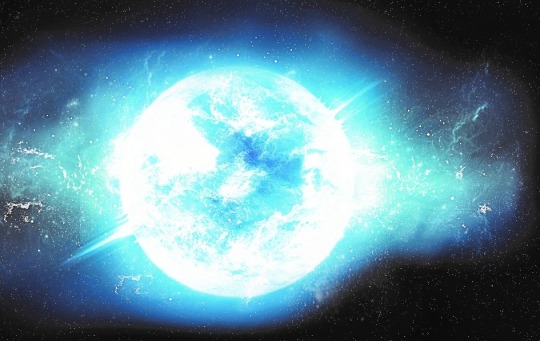
Smaller stars, such as red dwarfs, don't make it to the red giant state. They simply burn through all of their hydrogen, ending the process as a dim white dwarf. However, red dwarfs take trillions of years to consume their fuel, far longer than the 13.8-billion-year-old age of the universe, so no red dwarfs have yet become white dwarfs.
When a star runs out of fuel, it no longer experiences an outward push from the process of fusion and it collapses inward on itself.

White dwarfs contain approximately the mass of the sun but have roughly the radius of Earth, according to Cosmos, the astronomy encyclopedia from Swinburne University in Australia. This makes them among the densest objects in space, beaten out only by neutron stars and black holes. According to NASA, the gravity on the surface of a white dwarf is 350,000 times that of gravity on Earth. That means a 150-pound (68-kilogram) person on Earth would weigh 50 million pounds (22.7 million kg) on the surface of a white dwarf.

White dwarfs reach this incredible density because they are collapsed so tightly that their electrons are smashed together, forming what is called "degenerate matter." The former stars will keep collapsing until the electrons themselves provide enough of an outward-pressing force to halt the crunch. The more mass, the greater the pull inward, so a more massive white dwarf has a smaller radius than its less massive counterpart.
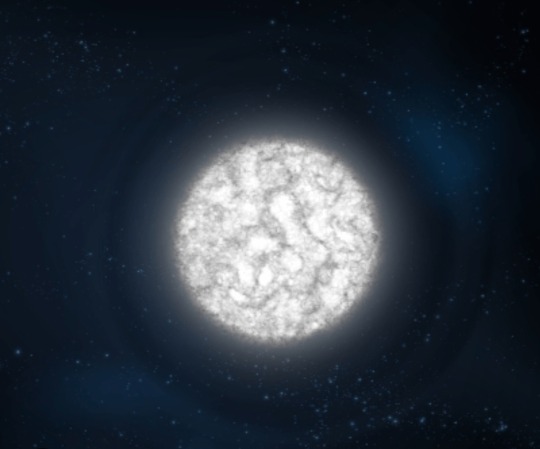
Those conditions mean that, after shedding much of its mass during the red giant phase, no white dwarf can exceed 1.4 times the mass of the sun.
When a star swells up to become a red giant, it engulfs its closest planets. But some can still survive. NASA’s Spitzer spacecraft revealed that at least 1 to 3 percent of white dwarf stars have contaminated atmospheres that suggest rocky material has fallen into them.
Originally published on www.space.com
COMING UP!!
(Wednesday, December 13th, 2023)
"METHUSELAH STAR IS THE OLDEST STAR IN OUR UNIVERSE??"
#astronomy#outer space#alternate universe#astrophysics#universe#spacecraft#white universe#space#parallel universe#astrophotography#stars#white star
105 notes
·
View notes
Text

From e-waste to gold: A pathway to CO₂ sustainability
A Cornell-led research team has developed a method for extracting gold from electronics waste, then using the recovered precious metal as a catalyst for converting carbon dioxide (CO2), a greenhouse gas, to organic materials. The method could provide a sustainable use for some of the approximately 50 million tons of e-waste discarded each year, only 20% of which is recycled, according to Amin Zadehnazari, a postdoctoral researcher in the lab of Alireza Abbaspourrad, the Yongkeun Joh Associate Professor of Food Chemistry and Ingredient Technology in the College of Agriculture and Life Sciences. Zadehnazari synthesized a pair of vinyl-linked covalent organic frameworks (VCOFs) to remove gold ions and nanoparticles from circuit boards in discarded electronic devices. One of his VCOFs was shown to selectively capture 99.9% of the gold and very little of other metals, including nickel and copper, from the devices.
Read more.
#Materials Science#Science#Electronics#Waste#Carbon dioxide#Gold#Catalysts#Covalent organic frameworks#COFs#Cornell University
14 notes
·
View notes
Text
The Evolution of PCB Manufacturing: From Basics to High-Performance Boards
PCB manufacturing has evolved from single-layer boards to high-performance, multi-layered designs, enabling innovation in automotive, healthcare, telecommunications, and aerospace. Learn how cutting-edge PCB technologies support modern electronics and drive UK industries forward. Explore advanced PCB solutions for your business today.
#PCB manufacturing evolution#high-performance PCBs#multi-layer PCB design#PCB for 5G networks#advanced PCB technology#UK PCB industry#flexible PCBs#PCB signal integrity#automotive PCB solutions#medical device PCBs#aerospace PCB manufacturing#PCB miniaturisation#HDI PCBs#thermal management in PCBs#next-gen PCB solutions#A-Gas Electronic Materials
0 notes
Text
This sound-suppressing silk can create quiet spaces
New Post has been published on https://thedigitalinsider.com/this-sound-suppressing-silk-can-create-quiet-spaces/
This sound-suppressing silk can create quiet spaces


We are living in a very noisy world. From the hum of traffic outside your window to the next-door neighbor’s blaring TV to sounds from a co-worker’s cubicle, unwanted noise remains a resounding problem.
To cut through the din, an interdisciplinary collaboration of researchers from MIT and elsewhere developed a sound-suppressing silk fabric that could be used to create quiet spaces.
The fabric, which is barely thicker than a human hair, contains a special fiber that vibrates when a voltage is applied to it. The researchers leveraged those vibrations to suppress sound in two different ways.
In one, the vibrating fabric generates sound waves that interfere with an unwanted noise to cancel it out, similar to noise-canceling headphones, which work well in a small space like your ears but do not work in large enclosures like rooms or planes.
In the other, more surprising technique, the fabric is held still to suppress vibrations that are key to the transmission of sound. This prevents noise from being transmitted through the fabric and quiets the volume beyond. This second approach allows for noise reduction in much larger spaces like rooms or cars.
By using common materials like silk, canvas, and muslin, the researchers created noise-suppressing fabrics which would be practical to implement in real-world spaces. For instance, one could use such a fabric to make dividers in open workspaces or thin fabric walls that prevent sound from getting through.
“Noise is a lot easier to create than quiet. In fact, to keep noise out we dedicate a lot of space to thick walls. [First author] Grace’s work provides a new mechanism for creating quiet spaces with a thin sheet of fabric,” says Yoel Fink, a professor in the departments of Materials Science and Engineering and Electrical Engineering and Computer Science, a Research Laboratory of Electronics principal investigator, and senior author of a paper on the fabric.
The study’s lead author is Grace (Noel) Yang SM ’21, PhD ’24. Co-authors include MIT graduate students Taigyu Joo, Hyunhee Lee, Henry Cheung, and Yongyi Zhao; Zachary Smith, the Robert N. Noyce Career Development Professor of Chemical Engineering at MIT; graduate student Guanchun Rui and professor Lei Zhu of Case Western University; graduate student Jinuan Lin and Assistant Professor Chu Ma of the University of Wisconsin at Madison; and Latika Balachander, a graduate student at the Rhode Island School of Design. An open-access paper about the research appeared recently in Advanced Materials.
Silky silence
The sound-suppressing silk builds off the group’s prior work to create fabric microphones.
In that research, they sewed a single strand of piezoelectric fiber into fabric. Piezoelectric materials produce an electrical signal when squeezed or bent. When a nearby noise causes the fabric to vibrate, the piezoelectric fiber converts those vibrations into an electrical signal, which can capture the sound.
In the new work, the researchers flipped that idea to create a fabric loudspeaker that can be used to cancel out soundwaves.
“While we can use fabric to create sound, there is already so much noise in our world. We thought creating silence could be even more valuable,” Yang says.
Applying an electrical signal to the piezoelectric fiber causes it to vibrate, which generates sound. The researchers demonstrated this by playing Bach’s “Air” using a 130-micrometer sheet of silk mounted on a circular frame.
To enable direct sound suppression, the researchers use a silk fabric loudspeaker to emit sound waves that destructively interfere with unwanted sound waves. They control the vibrations of the piezoelectric fiber so that sound waves emitted by the fabric are opposite of unwanted sound waves that strike the fabric, which can cancel out the noise.
However, this technique is only effective over a small area. So, the researchers built off this idea to develop a technique that uses fabric vibrations to suppress sound in much larger areas, like a bedroom.
Let’s say your next-door neighbors are playing foosball in the middle of the night. You hear noise in your bedroom because the sound in their apartment causes your shared wall to vibrate, which forms sound waves on your side.
To suppress that sound, the researchers could place the silk fabric onto your side of the shared wall, controlling the vibrations in the fiber to force the fabric to remain still. This vibration-mediated suppression prevents sound from being transmitted through the fabric.
“If we can control those vibrations and stop them from happening, we can stop the noise that is generated, as well,” Yang says.
A mirror for sound
Surprisingly, the researchers found that holding the fabric still causes sound to be reflected by the fabric, resulting in a thin piece of silk that reflects sound like a mirror does with light.
Their experiments also revealed that both the mechanical properties of a fabric and the size of its pores affect the efficiency of sound generation. While silk and muslin have similar mechanical properties, the smaller pore sizes of silk make it a better fabric loudspeaker.
But the effective pore size also depends on the frequency of sound waves. If the frequency is low enough, even a fabric with relatively large pores could function effectively, Yang says.
When they tested the silk fabric in direct suppression mode, the researchers found that it could significantly reduce the volume of sounds up to 65 decibels (about as loud as enthusiastic human conversation). In vibration-mediated suppression mode, the fabric could reduce sound transmission up to 75 percent.
These results were only possible due to a robust group of collaborators, Fink says. Graduate students at the Rhode Island School of Design helped the researchers understand the details of constructing fabrics; scientists at the University of Wisconsin at Madison conducted simulations; researchers at Case Western Reserve University characterized materials; and chemical engineers in the Smith Group at MIT used their expertise in gas membrane separation to measure airflow through the fabric.
Moving forward, the researchers want to explore the use of their fabric to block sound of multiple frequencies. This would likely require complex signal processing and additional electronics.
In addition, they want to further study the architecture of the fabric to see how changing things like the number of piezoelectric fibers, the direction in which they are sewn, or the applied voltages could improve performance.
“There are a lot of knobs we can turn to make this sound-suppressing fabric really effective. We want to get people thinking about controlling structural vibrations to suppress sound. This is just the beginning,” says Yang.
This work is funded, in part, by the National Science Foundation (NSF), the Army Research Office (ARO), the Defense Threat Reduction Agency (DTRA), and the Wisconsin Alumni Research Foundation.
#advanced materials#air#approach#architecture#canvas#Capture#career#career development#Cars#chemical#Chemical engineering#Collaboration#computer#Computer Science#defense#Design#details#development#direction#ears#efficiency#Electrical Engineering&Computer Science (eecs)#Electronics#engineering#engineers#fiber#fibers#Forms#Foundation#gas
0 notes
Text

Solar Aether “For the wild nature was not yet overcome, and light and darkness wrestled so long the one with the other, till the sun arose, and with its heat forced this tree, so that it did bear pleasant sweet fruit; that is, till there came the Prince of Light, out of the heart of God, and became man in nature, and wrestled in his human body, in the power of the divine light, in the wild nature.” ― Jakob Böhme
The Ethers and the Spiritual Worlds
“What we call chemical action is projected into the physical world from the world of Devachan — the realm of the Harmony of the Spheres. In the combination of two substances according to their atomic weights, we have a reflection of two tones of the Harmony of the Spheres. The chemical affinity between two substances in the physical world is like a reflection from the realm of the Harmony of the Spheres. The numerical ratios in chemistry are an expression of the numerical ratios of the Harmony of the Spheres, which has become dumb and silent owing to the densification of matter. If man were able to etherealize material substance and to perceive the atomic numbers the inner formative principle thereof, he would be hearing the Harmony of the Spheres.” --Esoteric Christianity and the Mission of Christian Rosenkreutz, Lecture 6, 1 October 1911
But what of the other ethers, are they also bearers of different ‘realms’ of the spiritual world?
In the lecture quoted above, there follows a diagram indicating that a relationship exists between light ether and the astral world, tone ether and lower Devachan, also called the Harmony of the Spheres, and life ether and higher Devachan.
These ‘layers’ of the spiritual world interpenetrate; they are not spatially separate. In Anthroposophy, the names for these worlds changes depending on the perspective from which they are described (see CW17 The Threshold of the Spiritual World, Chapter 16). The astral world is the closest realm to the world we ordinarily perceive, it is also called the soul world or the elemental world. Devachan is the pure spiritual world – called Spiritland in Theosophy (CW9), the realm of archetypes. These realms are accessible to different forms of spiritual cognition and from this perspective are also called the worlds of Imagination (astral world), Inspiration (lower Devachan) and Intuition (higher Devachan). We can examine the nature of these three spiritual worlds to gain a better understanding of what is meant by light, tone and life.
26 notes
·
View notes
Text
The Mysteries of the Sun. Part 2

Credit to #NASA
The Mysteries of the Sun. Part 1
So, any small star, like our Sun, consists mainly of hydrogen and helium, gradually converting one into the other. These are gases in a plasma state, meaning the gas molecules have broken down into nuclei (positively charged ions) and negatively charged electrons. Near the Sun's visible surface, the atmosphere is very sparse, and the deeper you go, the denser it becomes. Initially, the gas takes on a texture similar to liquid, then this liquid becomes thicker, resembling Earth's magma. At the very core of the star, the pressure and density are so immense that the environment is akin to a hot, dense core, where atoms can no longer move relative to each other.
And if the Sun's surface rotates in that strange way we mentioned—where the equatorial part completes a rotation every 27 days—scientists have recently discovered that the core rotates even faster, completing one rotation in about a week. What's more, the core is slightly offset from the Sun's center.
As I mentioned in our previous conversation, convection cells form on the Sun's surface due to the flow of hot and cold matter: hot masses rise to the surface, while cooler ones sink. This happens both in the thin atmospheric layers, where these cells are small, and deeper within the star. The deeper you go, the larger and more global these flows become. The most significant process carries matter from the dense core of the star toward the equatorial region.
Imagine a ballerina spinning with her skirt flaring outward—something similar happens inside the star. Masses of solar material rise in the equator area from the depth toward the surface under the influence of centrifugal force. However, gravity pulls them back, preventing them from escaping too far. As a result, streams of solar matter spread across the surface from the equator toward the poles—north and south—cooling as they move.

But despite all the complexity of the Sun's activity, this is actually the simplest part of its fascinating internal dynamics. Next time, we'll dive into the even more intriguing topic of magnetic fields and electromagnetic processes.
The next part 3 is here
9 notes
·
View notes
Text
Casino Fic pt2
it’s here! And done, finally. Not my best work but it’s something. Enjoy my fellow fans of this silly little series, and I’ll see you in the stars.
Finian:
It was the most ridiculous plan possible. We were going to start a riot, and then use an improvised shaped charge made from a longbow HE shell and 20 kilos of high grade explosive. Which just so happen to be stored in this apartment. Turns out, this place has an armory. And it’s this gearheads wet dream. One of them anyways, this one has less red hair.
Body armor, smoke grenades, chemical irritants, breaching charges, EMPs, everything and anything one could need. I was like a kid ima candy shop and damn near skipped through grabbing pieces. A primer from a flashbang here, an electronic fuse there, and enough plastic explosive to flatten a small skyscraper.
Now, a shaped charge is a very funny thing. The idea is you made a special shape out of explosives, and in doing so, create an explosive lens. A normal stick of TNT wouldn’t put a dent in a meter thick steel plate, but a shaped charge with the same amount of explosive? It could penetrate 2 or more, if you made it well.
Mine would be quick and dirty, as much as a bomb could be while being a bomb. I made up for the imperfect lens with raw power. If my calculations are correct, this should be able to penetrate the vault a few times over, so hopefully I can blow a hole into through enough walls to get the gang in through a publicly accessible area. That was the second part of the plan, an EMP and a 20 cubic meters of pure CS gas. Otherwise known as tear gas. The idea will be to blow the tear gas, cause a panic, blow the EMP to wipe the computer systems and break the ventilation, then blow into the vault. What could go wrong?
I repeated this to myself as I assembled our IED. This is not what I imagined when I signed up for the legion, but I can’t complain. I’m saving for he universe, hopefully.
With shaking hands and a grimace, I placed the primer in the charge. It couldn’t explode without the detonated, which won’t be installed until it needs to go bang, but still, twenty kilos of explosive would atomize me, and turn the rest of the squad alternating into piles of ash or a fine red mist.
With a click, the primer nestled itself in its compartment, and the bomb was ready. All that was left to do now was to wait for the right moment.
Tyler looked up from the other end of the table. “Done?”
“Yes sir”
“Good. 0 Hour is tomorrow, 6PM. 28 hours time. You are released from duties for the next 24. Good work fin. There’s no one I would trust to build me a bomb more than you.”
“I appreciate that sir, but I doubt I can put it on a resume”
Tyler chuckled
“Indeed it doesn’t.”
I stowed my tools, placed the little contraption of metal and hate in the explosives vault in the armory, and went to find Scarlett.
Scarlett
I was lounging around outside, enjoying the sun when Finian found me.
“Your evil and cruel brother has released me from his weapons factory”
I started at his voice, and spun on my lounger.
“Well good. Now we can go shopping, this figure won’t clothe itself ya know.”
I rolled off the lounger and could almost hear Finian’s mind grind to a halt when he saw what I was wearing (thank the maker whoever furnished this place left me a bikini).
“I-uh-the-j-my….”
As I walked past him I whispered in his ear
“Now now, get your head on straight. It only gets better”
His eyes locked on a point in the distance, and then he spun on his heel and followed me in.
I meandered back to my room, thinking about what I would wear on this outing. I opened the doors to the closet, and started throwing bits and bobs onto the bed. A hoodie there, a skirt there, the works. Once I had about five outfits worth I started sorting things out. I settled on nothing, and figuring this was a high class setting, grabbed on of the lighter dresses from the closet. It was made of some light, shimmering material that didn’t have a set color. I paired it with some nice heels, and a pair of hoop earrings. It was all going well, until the zipper.
Unfortunately, it was small and impossible to grab over my shoulder. I considered my options for a moment before remembering the door to Finians room. I went into the little hallway and banged on his door.
“De Seel! Let me in!”
His yell was muffled by the door
“Let yourself in! It isn’t locked!”
I opened the door and stepped into the room, then started floating. I was about to yell before I remembered: it’s Finians room, no wonder.
I tried to make it beyond the doorway, but I had spent my entire zero G orientation course flirting with a boy (ex boyfriend number: oh wait never mind we never dated) fins head poked around the door to what I assumed was his bathroom
“What do you need? I’m a bit busy here.”
I noticed the water droplets in his hair.
“Just..” I flailed, trying to stop the gentle spin I had somehow managed to give myself “the dress. I can’t reach the zipper.”
He pinched his arm. “Ok, not a dream then. Sure, give me a second to… get decent.”
He ducked back into his bathroom, and with the rustle of clothes, popped his head back out, now with a shirt on his shoulders and less water in his hair, and pushed off the frame toward me.
He was extremely graceful in zero G. I suppose you have to be when you love in it for most of your life. I saw his exo docked in a corner, seemingly fixed as I spun around. He hooked his hand on the sideboard and came to a stop next to me.
“Your hand, if you please?”
Tyler:
It was go time. Each squad member was in the center of the room, dressed in uniform. The backpack containing the IED and the distraction sat in the centre.
“This is it squad. Go time. Everyone know your parts?”
6 voices responded in the affirmative.
“Good. Then let’s rock and roll”
It took us twenty minutes to make it to the casino. The crowds were huge, everyone was gathering to watch the screens before the race up in orbit started. Security was swamped, and so we snuck in easily. Me and Fin looked at each other, set the distractions timer for 30 minutes, and I stashed it away where it wouldn’t be seen. Kal and Aurora milled around the center of the massive gambling hall, ready to back up whoever needed it. Finian and Scar stood near the bar, blending in with the rash of other patrons. Meanwhile me and Cat stood in a crowd of people watching the vidscreens.
They were the longest 30 minutes of my life, but eventually it went off.
There was an immersion buzz as EM radiation fried every electrical device in half a kilometer. The digital slot machines sparked and died, holoscreens belched smoke, and then the hiss of gas filled the room. A great cloud of white gas billowing through the room. Every member of the squad, with practiced efficiency, donned gas masks, sealing out the gas and hiding our identities. I ran over and pulled the nearest fire alarm, to increase the panic, and then hid in an alcove with cat while we waited for the stampede of the crowd to pass. As they did, we barricaded the doors, and prepared to breach the vault. I found the spot, planted the charge against the wall of the gambling hall, and tried to insert the detonator. It made it half way in before getting stuck. I tried again, and the same thing happened. I motioned for the squad to move away, and voice muffled by the mask, warned them
“This detonator is jammed, I’m going to have to force it in.”
Finian’s eyes widened behind his mask
“Be careful. If you get it wrong that thing will go off in your face , literally.”
“Then MOVE IT!”
The squad backed off, sheltering behind a half wall near the roulette tables
“Here goes nothing”
I grabbed the hammer from the kit, took a deep breath, and swung.
Aurora
There was an ear splitting bang as the worst happened, the bomb went off when Tyler installed the detonator. We all rushed over and found him thrown a good 20 feed by the blast, covered in debris and soot. Where there had once been a wall, there now was a 5x3 hole that stretched a good 60 feet.
Cat started barking orders.
“SCAR! PIXIEBOY! MOVE TYLER NOW! I WANT HIM TRIAGED YESTERDAY!”
“FINIAN! GET COMMS UP! WE NEED ZILA!”
“STOWAWAY! WITH ME! WE CAME FOR THIS FUCKING ROCK AND ILL BE DAMNED IF WE LEAVE WITHOUT IT!”
Cat practically dragged me through to the vault, the metal warped in strange ways by the super high temperatures and rapid recompression. We found ourselves in the main room, and right before us, luckily blown out of its safe box, was the gem, glittering gently.
“GRAB IT AND LETS GO!”
I picked it up and ran back toward the rest of the squad, ducking through the holes the bomb bored. I found Tyler moved, with Kal and Scarlett systematically checking him over for damage. My ears were ringing and I couldn’t hear them but I assumed he wasn’t in any imminent danger.
What I could hear over the tinnitus was a banging. Repeated and forceful.
“GUYS WE HAVE COMPANY!”
The police had shown up, and were battering down the doors.
We stood no chance if they were here already. Something or someone had tipped them off.
Cat looked up just and the doors started to splinter.
“FUCK! KAL, GET YOUR ASS OVER HERE WE GOTTA FIGHT THEM OFF”
The door exploded into a million pieces, looks like the cops used breaching charges to finish the job.
They sprinted in, disruptors raised and shouting orders
“GET DOWN ON THE GROUND! HANDS IN THE AIR!”
One looked at me
“DROP THE FUCKING CRYSTAL NOW!”
I tried, but my hand wouldn’t unclench. It started glowing, ever brighter until I couldn’t see it any more, and it got brighter still. It threw the entire room into sharp relief, and blinded me and presumably everyone else and I had to close my eyes. It flickered and flashed, and suddenly I wasn’t standing on carpet anymore. I opened my eyes and found myself in the hall of the apartment, along with the squad. Zila stared from the central room.
“I see. Curious indeed”
And then I fainted.
Finian:
This day just kept getting better and better.
Kal and Cat carried Aurora over to the couch to wait for “trained” “medical” personnel to attend to her, in the meantime, Zila and I converted the dining table into a makeshift operating theatre. The bomb going off at that close to Tyler had predictable effects on him. Light shrapnel, burns. The real problem was the hammer. It had gone flying back with the explosion. The force had dislocated 3 of his fingers, and ripped the other two clean off. Luckily (or as lucky as one can be in this circumstance) the stumps of the fingers had been cauterized by the explosion, meaning he hadn’t lost much blood. Zila used her uni to image his hand, and ensured nothing had broken, which meant the dislocated fingers were simple enough to fix, but the missing fingers were a total write off. The nerves had been cooked, the most we could do was stop it from getting infected. I would make him cybernetics but it would take time.
While I sorted out what I could, mostly cleaning and bandaging lacerations, Zila inspected Aurora. Scarlett came over and helped me, the worry etched into her features. By my estimation, our glorious leader wouldn’t be up and about for 2 days at least, and would need a week or more to be back to reasonable health. The other thing: poor guy would hurt everywhere. Tinnitus, bruising, a probable concussion, burns. And that’s just his head and shoulders. His right arm would hurt like a bastard when he woke up. But he would recover, and I stressed that to Scar. Once we had bandaged him up I got Kal to help me move him to his bed. I gave him a lidocaine injection in his hand, normally it’s used for dental work but it will numb the pain all the same. Why do our med supplies contain dental painkillers? Who knows at this point. I may as well be a marionette on a string for all I know. Meanwhile Scarlett was pacing a hole in the carpet, shaking and muttering to herself.
I walked over and grabbed her arm as gentle as I could be. She still jumped
“Scar, scar you need to sit down. I’ll get you something to eat just sit at the counter ok?”
“No fin I- I- I need to- I”
She couldn’t get the words out. She broke down sobbing. I couldn’t think of anything better to do so….
I hugged her
What I wasn’t expecting was for her to reciprocate it immediately. She locked me in a vice grip, like a drowning man clutches a life ring.
“Fin- fin w-w-what are we going to do?”
“I don’t know… but your brother will be alright. Focus on that. Ground yourself. Come on, let’s get you something from the kitchen, when did you eat last?”
I walked her over to the kitchen and sat her down. I started rifling through the cabinets, looking for something, anything to get her.
I made her some herbal tea I found, mixed it with honey, and put some plain biscuits on a plate for her.
“Scar, Scar honey, try eating something. I know you feel awful and everything feels like it’s going wrong but it will be ok. Say it with me:”
She said it with me, voice scratchy and unstable
“It will be ok”
“Good. I’m going to go check on your brother, now sit there and try to drink some tea at least. It will help your nerves.”
I probably didn’t need to check on Tyler, but doing so reassured her that he was still here. You learn a lot when you spend a year in hospital. Most important of which is how to keep people calm. Most of it I never used, but occasionally it comes in handy.
Tyler was fine, still unconscious, wrapped in blankets and bandaids.
Tyler:
I woke slowly. Each of my senses returned as they pleased. Even then I could feel something was wrong. Two of my fingers couldn’t feel anything. I tried to move my hand to look at it but found that my motor function had abandoned me. Slowly my hearing came back, accompanied by a quiet, edge of hearing whine. It took my brain some time to figure out what was going on. The word flashed in my head like an alarm bell: tinnitus.
‘How could I have-‘
My memory finally joined the party. The bomb. It must have gone off when I installed the detonator. My eyes shot open and- I couldn’t see anything. Not clearly anyways. It was too bright in my room for my poor, delicate eyes that had spent the past…… however long…….. in darkness.
It took several tries, but my eyes eventually started adjusting to the light. I was in my room in the apartment. The curtains were open and the sun was streaming in. I tried to move, and found that my bones were made of lead. It took an ungodly amount of effort to even lift my arm.
I managed to flop my right arm up into a spot where I could see it, and was rewarded with a sharp shock of pain. Most of my skin was covered in bandages from the elbow down, and what little I could see was an alternating patchwork of the shiny red of burns and the indigos of bruises. My eyes strayed down to my hand, three of my fingers were splinted and two….
Where were the other two?
Oh shit
I tried to move the two fingers that weren’t there, desperate to reveal that it was a trick of the light or some weird bandaging. A small moan escaped my lips as torn muscle and brutalized nerves twitched and pulled at something that wasn’t there any more.
The noise set off some sort of bedside monitoring equipment, and I heard the thump of feet as the door opened to reveal Cat, who, upon seeing that I was in fact awake, yelled over her shoulder
“ZILA! HE’S AWAKE!”
I heard a second set of footsteps come up the hall, and both of my squadmates walked into the room
“Good morning sir. You have been unconscious for 36 hours. I would advise against any further movement. You have been seriously injured.”
I tried to say something but moving my jaw sent fiery waves of agony through my ears.
“Don’t try and talk ty, you royally fucked up your eardrums.”
Zila walked over and past the edge of my vision.
“I am giving you a further dose of painkillers and sedatives. You require more rest.”
“Sweet dreams Ty”
And then I was dragged away from consciousness, pains and aches fading to nothing as I once again drifted off to sleep.
A/N: I don’t remember writing the below chapter so uhhhh. Included for posterity but I genuinely don’t remember what I was doing with this.
Scarlett:
I had drank the tea that Finian gave me and collapsed onto the couch. It was all too much to process. I just laid there for a while, and eventually drifted off to sleep.
My sleep was restless, my mind flitted between replaying what happened in the casino and nightmares about tyler. The last thing I dreamt was that I was back at our house on Earth, standing out on the balcony, and everywhere I could see was covered in a sickly green-blue snow.
I woke with a start, drenched in sweat and shivering. I tapped at my uni with stiff fingers trying to pull up the time, but to no avail. I had forgotten to charge it.
I rolled off the couch, too exhausted to try and sit up properly, and staggered as I stood, knees protesting their mistreatment. Legs weak and shivering from the cold of air conditioning on damp clothes, I stumbled over to the door to the balcony, desperately seeking warmth. I forced the sliding door open and emerged into the evening warmth. The sky was lit a burning orange with the sun tickling the horizon set over deep blue ocean. It was a truly breathtaking sight, and I can only imagine what the apartment must have cost. This was the kind of view most people would only ever see in photos and magazines. Also out here was Finian, lounging on a chair with someone hung clamped between his teeth. He took a deep breath, tipped his head back, and let out an equally long sigh.
“What’s that?”
He jumped whirled around with pure panic in his eyes, and then immediately relaxed.
“Oh, it’s just you. You scared me there, thought you were someone I would have to hide this from.”
He brandished a small paper cone, end glowing but not smoking.
“What is it?”
“A little bit of against regs fun that I’ve made specifically for my own…. Needs.”
“A cigarette?”
“Much better. This is the finest weed you can get on the station. Smokeless, Odorless, strong. I grow it myself in a maintenance cupboard.”
“The kind of thing that would get you thrown out faster than light speed if you got caught with it?”
“Bah. Every stream has their vices that command ignores if it doesn’t cause trouble. The Aces have drinking, the Faces have gambling, as you well know, the Tanks have steroids, the brains have whatever madness they can cook up in a lab, the gearheads have grass, and the Alphas…. Well I’ve heard rumors about what they do.”
“Rumors?”
“Let’s say…. They keep their own tight lipped on what goes on. I’ve heard a million things but nothing concrete.”
“But why are you, ya know, indulging? I figured with your, er… unique circumstances-“
“You can call me disabled Scar.”
“Regardless of what we call it, I would have assumed that it wouldn’t be good for you. Well, even worse for you I suppose.”
“Ah, but Assumptions make an ass of you and me. And I’m not bad at botany, and chemistry. I’ve cultivated a very clean strain, and I chemically purify it. The roll is for looks more than anything. It’s absorbed into my bloodstream via my mouth rather than my lungs. No oder, no coughing, minimal side effects. If I wasn’t on the run from galactic authorities and a member of a peacekeeping force I would just go into business selling the stuff.”
“And why are you… smoking is the wrong word… uhhh…. Ah screw it. Why are you smoking?”
“Because in the past… how long? Week? 8 days? I don’t know. In the past however many days I’ve had to play pretend as a missile operator, businessman, trauma medic, surgeon, central commander, bomb maker, terrorist, and therapist on top of my normal duties. And this is the closest to a vacation I will get before I’m inevitably locked away in a lunar prison colony. And because I want to. care to partake?”
“I don’t know, I’ve never tried it.”
“Don’t play the fool with me Scarlett Jones. I know about that party you and the other faces had the night you all graduated. 3000 credits in winnings and you blew all of it one whatever social lubricants you could get your and your compatriots’ grubby little hands on. Hell some of my stock ended up at that party, and I have no idea how.”
“Oh god, you know about that?”
“When every single one of the dealers of vice aboard a station suddenly have no stock, rumors spread.”
He pulled another roll from a hidden compartment hidden in the upper arm of his exosuit and passed it to me
“How do I light it?”
“Twist the bottom. It’s not an actual flame, but it does indicate how full it is.”
I twisted the bottom, where the filter would be if it were an actual roll, and placed it between my lips.
We sat in silence for a few minutes before I let out a groan.
“You weren’t lying… this really is the good stuff”
“The great face of the legion couldn’t determine my authenticity by the subtle twitching in my eyelashes or something else equally pretentious? For shame…”
That got a giggle out me.
“Well Sir, sometimes one’s gut instincts are wrong, and so experience must be aquired to confirm one’s claims” I exclaimed with a snooty upper class accent.
That got a chuckle out of him, the chuckle turning to a laugh to the point that he was doubled over in his seat crying with laughter.
At some point I joined in, It wasn’t even that funny but between the stress and the weed we both just needed to laugh it out. One the laughter subsided and we both recovered from our mirth we sat in silence again.
“Here, let’s go inside. The sun is almost gone and I doubt we will be alone for much longer. Ole pixie in there” he gestured over his soldier with his thumb “likes to come out and meditate or something.”
I stood, everything feeling slightly loose from the roll, as he rose beside me with the clicking and whirring of motors.
“Well then handsome, how do you feel about a sleepover?”
I saw a glimmer of fear on his eyes for just a moment. It just so visible I could have touched it. A night in full G, all of the feelings bouncing around in his head.
“Don’t worry, in your room.”
Cat:
Tyler was out for another 24 hours. Zila went in at 8 hour intervals to switch out saline drips and check on wound dressings but that was the limit of what could be done. Our medical supplies were limited at best and so most of the work was on Tyler’s own body. Unfortunately, that meant there was fuck all for me to do. One can only watch the holo feeds for so long before going stir crazy, and so I spent most of my time going over the operating procedures for our souped up longbow.
Did you know it has hidden cupholder in each of the stations? I didn’t.
At some point the dry wording and useless numbers carried me off to a restless night of sleep. By the time I woke up the first hints of dawn were appearing out on the horizon, red and orange bands staining the clouds a bloody red. I went into Tyler’s room to check in him, for something to do more than any real need. I sat in the corner for a few minutes watching the gentle rise and fall of his chest.
I was about to leave when the gentle rhythm of his breath was interrupted, and he began to stir from his chemically induced slumber. It was fascinating to me that no matter what, however or wherever he woke up, he did the same thing. It started with a twitch in his arm, and then a gasp before his eyes fluttered open. This time however, a gentle groan escaped his lips.
I rushed over to his bedside, and before I realized what I was doing, was gently stroking his forehead.
“Shhhh Ty, it’s ok, your ok.”
His eyes darted over to me, and his jaw twitched almost imperceptibly. With the softest rasp he spoke
“w-w-water.”
I glanced around the room before seeing a glass on the bedside table. I cradled the back of his head and lifted it up off the pillow as I held the glass to his lips as gently as I could. He drank greedily, trying to wash the taste of blood and medicine out of his mouth, or so I presume.
When he had finished, I set the glass back on the table and lowered his head back to the pillow.
“w-w-what d-d-day is it?”
“Sunday. 6:30 in the morning.”
No response escaped him, except for the gentle whisper of his breath. His head twitched, and ever so slowly he turned to face the sunrise. Even in his state, I could read it in his body language, he was drinking in the sight of sunrise . I couldn’t blame him, it was nice, but personally I never understood the appeal they had to some people. Why look at one star when you could go fly and see millions?
Once again, barely moving at all, he turned to look at me.
“W-w-what H-“
“Shhhh. Don’t talk, you need to heal. The detonator was triggered by the hammer, our resident smartass thinks it expanded from your body heat, which is why it didn’t fit. The blast turned the wee hammer into a projectile. Your grip was loose enough that it didn’t break anything, but it obliterated the tendons in two of your fingers and they were ripped off. Everything else will heal, given time. Your hand will hurt like hell though, a triple dislocation is not a fun time.”
“T-the p-p-plan?”
“What did I tell you about not talking? Once you’re mobile, The plan is to pick up shop and get moving.”
He gave an almost imperceptible nod.
“Well then, my dear alpha, you best get to healing.”
Aurora:
I was sad to leave, the apartment was gorgeous and so was the locale. If we survived this, I would want to come back. As Cat fiddled with the controls and Tyler watched, still beaten and bruised, I fiddled with the gem and the trigger. No matter what i did, every orientation, position, angle, no matter what I did it just wouldn’t fit. It was almost like something was keeping the two apart. Just as we passed through the systems foldgate, the two pieces finally snapped together with a clack. *cue into Aurora Rising chapter 25*
7 notes
·
View notes